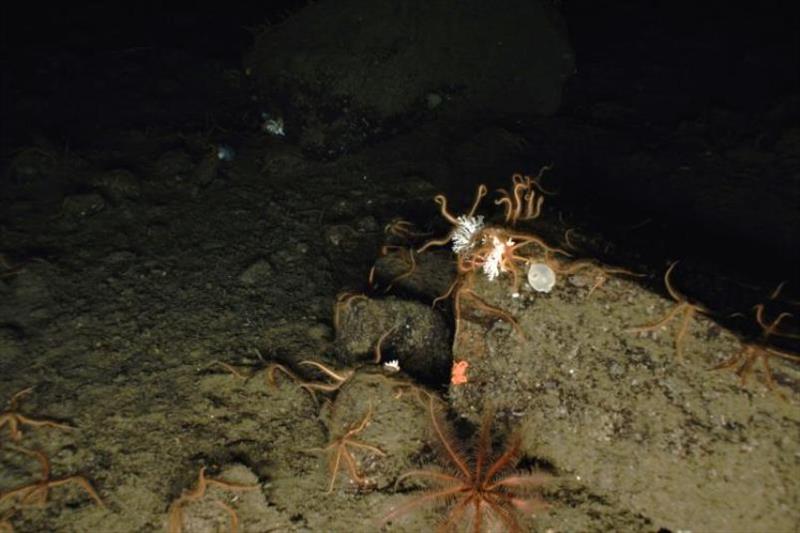
Science blog: a preview of exciting findings from leg 1 of Alaska deep-sea coral survey
by NOAA Fisheries 26 Jul 2022 18:21 UTC

Diverse benthic habitat, showing brittlestars, a crinoid, and stylasterid corals of the genus Stylaster. Stylasterid (Stylasteridae) corals are among the most important habitat-forming invertebrates in deep-sea coral ecosystems in the North Pacific © NOAA Fisheries
On Leg 1 we completed 125 drop camera deployments and made 248 eDNA collections. We made observations across a wide range of habitats, from inshore protected waters down to almost 800 m along the continental shelf and upper slope.
Deep Sea Corals
A minuscule amount of light penetrates beyond a depth of 200 meters and at deeper depths photosynthesis is no longer possible. But for deep-sea corals and sponges this is not a problem because they feed on planktonic organisms that flow in ocean currents. Their beautiful forms and structures are unique adaptations to the cold and dark environment.
In this diverse benthic habitat, we observed brittlestars, a crinoid, and stylasterid corals of the genus Stylaster. Stylasterid (Stylasteridae) corals are among the most important habitat-forming invertebrates in deep-sea coral ecosystems in the North Pacific. They are also known as 'lace corals' or 'hydrocorals'. Like their warm water cousins the stony coral, found in coral reefs, they have rigid skeletons made of calcium carbonate.
We also observed Tentacled Bamboo Coral (Isidella tentaculum). Bamboo coral's stony branches contain tiny polyps living and working together. The individual polyps stretch feathery tentacles into the currents to grasp plankton and other particles of food drifting in the currents. But despite their outward appearance, all have a knobby, stony skeleton inside. Some nudibranchs and sea star species may try to make a meal of a bamboo coral's polyps, but the colony can put up a fight. Fleshy sweeper tentacles loaded with stinging cells gently sway along the base to keep predators from crawling up to eat the polyps.
We also observed sea whips, types of octocorals - colonies of 8-tentacled polyp-like animals. Each sea whip is a colony of polyps (small anemone-like individuals) working together for the survival of the whole. The primary polyp loses its tentacles and becomes the stalk of the sea whip, with a bulb at its base—the bulb anchors the sea pen in the muddy or sandy bottom. The various secondary polyps form the sea whip's "branches" and have specialized functions.
Rockfish Habitat
We observed multiple species of rockfish in this unique habitat such as Rougheye, Sharpchin, and Redbanded species.
Rougheye rockfish (Sebastes aleutianus) range from Japan into the Bering Sea, throughout the Aleutian Islands, and south to San Diego, California. They can reach a maximum age estimated at least 205 years old, making them one of the longest-lived fishes in the world.
Sharpchin rockfish range from the Aleutian Islands, Alaska, to San Diego, California. They are most common at depths of 100 to 300 m (330-990 ft). Adults are usually found over cobble-mud or boulder-mud bottoms.
Sablefish Habitat
We observed sablefish during the dive as well. Sablefish are found in the northeastern Pacific Ocean from northern Mexico to the Gulf of Alaska, westward to the Aleutian Islands and into the Bering Sea. Juveniles have been found to migrate more than 2,000 miles in 6 or 7 years. Sablefish can also live to be more than 90 years old.
These corals, invertebrates, and fish all contribute to, support and define this deep-sea ecosystem, which is a distinctive habitat we've only just begun to explore.